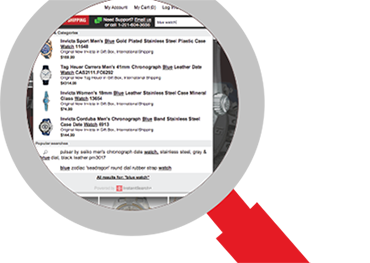CS-Cart: Tips to Power-Up Your Site Search


Ever wondered why the first result you get when you type "Harry Potter" on Amazon is an Amazon instant video? Or how does Apple know how to recommend Ipads, Iphones, when you merely type "ip" in the search box? Or why is it that those big brand names return search results so fast?
The answer is simple. These very successful companies realized how important search is to engage their users. They continuously invest in search technology to optimize both their user experience and promote their own chosen product at the same time.
How about you? Obviously you think that as a small, medium, or even large online merchant, you have neither the funds nor people to maintain an Amazon-like search on your web site. Think again. There are simple things you can do to significantly improve your site search, engage your visitors, and increase conversion rates.
Here are few tips on how to make eCommerce site-search work for you:
Have a SITE SEARCH on Your Site
While elementary, it is amazing how many sites don’t have any search on their web or mobile sites. These days, people have no patience and minimal attention span. Even on a small site with a small number of products, user will simply click away if they don’t find what they want quickly – especially on mobile devices. There is of course the browser-shopping paradigm, where online merchants have shoppers "browse" the shop, similarly to walking into a store and just looking at the merchandise. But even then, wouldn’t a shopper eventually ask a question? Or look for an item that she could not find on display? So, for your users’ sake – if you don’t have search for your site –get one.Make your search-box VISIBLE
What’s worse: not having a site search at all or making your search-box utterly invisible? Often, due to page design or theme considerations, search becomes a small magnifying glass icon that is hardly noticeable to the eye. Again, if you don’t show them where it is – they won’t use it. Put yourself in your site user’s shoes and try to find something on your site. Or even better, have someone else try to find something on your site, and watch how he fumbles. Make your search visible so that people can use it.Make sure your search is FAST
Especially when it comes to search – time is money. It’s been proven time and again. Low latency wins. Besides, Google is setting the golden standard here. If it takes Google a sub-second to find anything on the entire world-wide-web, why should it take more time to find an item on your web site? Do what you have to do to make it faster. Get a bigger server, more memory, or simply find a good cloud-based hosting that delivers fast results.
Use AUTOCOMPLETION in your Search Box
Ever since Google started with autocompletion or autosuggest a few years ago – without even knowing it, users have become addicted. When you start typing anything within a Google search box, you would immediately see a drop down box with at least 4 suggestive search queries. It’s extremely fast, and amazingly accurate in predicting what it is that you would like to search. Behind this simple mechanism lies a lot of technology and ginormous amount of data. Google takes signals from many sensors such as your search history, location, semantic analysis, emerging trends, and more, to predict what it is that you want to ask. In eCommerce, this concept extends to not only suggesting the search query but also suggesting the best-fit products. When the user selects a recommended product, she lands on the product page, and can click the Buy button without going through a results page. This accelerates the purchase cycle and increases conversion. If she selects a popular query rather than a recommended product, she would get to a result page for that query without the need to type the entire product name. This implicitly assures the user that they are not the only ones searching this query. I recommend using both product and search query suggestion, as they increase the likelihood of the user selection and accelerate conversion. Your users are using Google and Amazon. They are conditioned to expect autocompletion. If your site search engine has a decent autocompletion module – have it enabled. If you don’t have one, get an autocomplete product and install it.Use IMAGES with product names and descriptions
A picture is worth a thousand words. There is plenty of research in advertising on how an image and its placement on a page increases the likelihood of clicking an ad. Similarly in search, images are very powerful. Make sure that your product images appear in your search results page. If you are using autocompletion – make sure that suggestions include image thumbs for each product.Learn What People Are Looking For On Your Site
"You can’t manage what you can’t measure" the saying goes. Well, search is highly measureable. Most search engines, or hosted searches keep a list of search terms (search term is the professional name for what people are typing). From just looking at the list of search terms you see what users want. Moreover, you can see what they find and what they don’t. Based on that information, you can source new products, direct them to other products, or improve your search mechanism. All you have to do is view your search log or dashboard of your search service, and learn from it.
Leverage your search suggestions to PROMOTE PRODUCTS in search context
Getting back to the first question of the post: Ever wondered why the first result you get when you type "Harry Potter" on Amazon – is an Amazon instant video? Behind the scene, there is a sophisticated system that optimizes search results and product suggestions to what users are looking for. One could only guess that in this case, Amazon wants to offer its new instant video service to users who are looking for "Harry Potter". Amazon is probably taking into account both popular searches on its site and its own retailing strategy. It takes into account which products are best fit in terms of margin, inventory, promotion, and user preference. The beauty here is that the promotion is in the context of what the user is looking for. Had the user added the word "book" to its search query – instant video would be out of the list. A good site search engine or hosted service will allow you to have a fair amount of such sophistication: it would autocorrect typos so that users would get results even if they misspell, it would ignore out-of-stock items, or make certain products appear ahead of others in the suggestion list or the search result page.
source: instantsearchplus.com
Share
Article related products
Categories
Recent articles
Archives
You may be interested in


